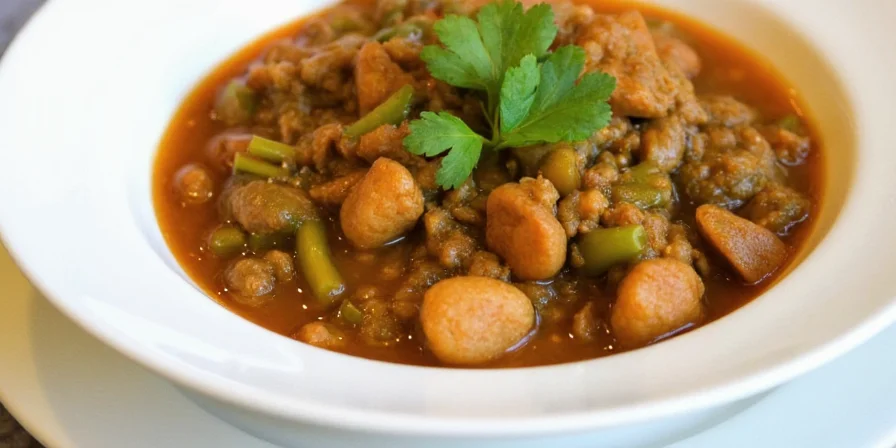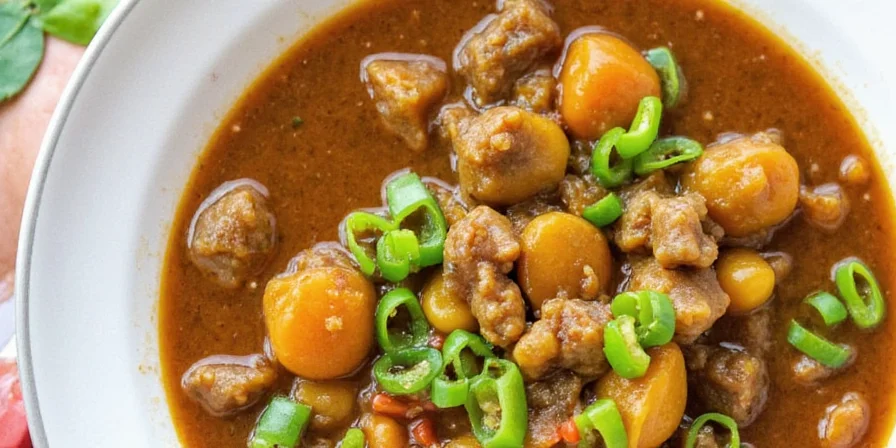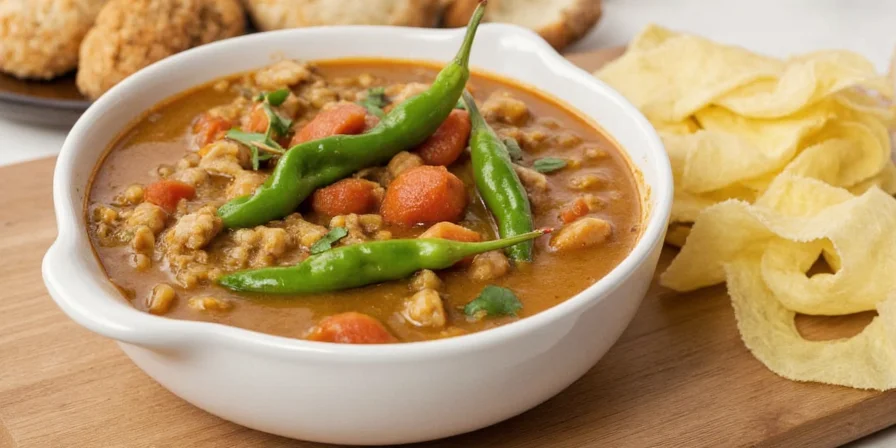Looking for the perfect green chili stew recipe? Here's a complete, authentic recipe with step-by-step instructions that delivers restaurant-quality results in 45 minutes. This version balances traditional Southwestern flavors with modern cooking techniques for a dish that's both comforting and sophisticated.
Authentic Green Chili Stew Recipe
Ingredients
- 2 lbs fresh Hatch green chilies, roasted and peeled
- 1.5 lbs pork shoulder, cut into 1-inch cubes
- 1 large onion, diced
- 4 garlic cloves, minced
- 2 tbsp cumin
- 1.5 cups chicken broth
- 1 cup tomatillos, husked and chopped
- 1 can (15 oz) cannellini beans, drained
- 2 tbsp apple cider vinegar
- Salt and pepper to taste
Step-by-Step Instructions
- Prepare chilies: Roast chilies over open flame until blistered. Place in covered bowl for 10 minutes, then peel and dice.
- Brown meat: In large pot, brown pork cubes on all sides over medium-high heat. Remove and set aside.
- Sauté aromatics: In same pot, cook onions until translucent. Add garlic and cumin, cooking for 1 minute until fragrant.
- Build stew: Return pork to pot. Add chilies, tomatillos, and broth. Bring to simmer.
- Simmer: Cover and cook for 20 minutes until pork is tender.
- Finish: Stir in beans and vinegar. Season with salt and pepper. Cook uncovered for 5 minutes.
| Feature | Green Chili Stew | Red Chili Stew |
|---|---|---|
| Base Chili | Fresh green chilies (e.g., Anaheim, Poblano) | Dried red chilies (e.g., Ancho, Guajillo) |
| Flavor Profile | Grassy, vegetal, slightly peppery | Smoky, fruity, earthy |
| Heat Level | Mild to medium | Moderate to high |
| Best For | Casual meals, weeknight dinners | Rich dishes, holiday feasts |


5 Pro Techniques for Elevated Green Chili Stew
Once you've mastered the basic recipe, these professional techniques will take your stew to the next level:
- Acid Timing: Add lime juice or apple cider vinegar halfway through cooking (not at the end) to preserve acidity that cuts through richness while integrating with other flavors.
- Bean Texture Layering: Combine canned white beans for creaminess with partially crushed dried beans for hearty thickness—creates complex mouthfeel in one pot.
- Ceramic Resting: Transfer cooled stew to a non-reactive ceramic vessel before refrigerating. The porous surface absorbs excess oil while enhancing flavor integration overnight.
- Seed Garnish: Sprinkle crushed pepitas toasted in chili oil for nutty contrast that elevates presentation without overpowering.
- Broth Selection: Use roasted vegetable or smoked turkey broth instead of plain water to build foundational savoriness that supports the chilies.


The Science Behind the Heat: Capsaicin Demystified
The fiery kick in green chili comes from a compound called capsaicin, found primarily in the seeds and inner membranes. While capsaicin is oil-based (which is why water doesn't help cool the burn), it also has scientifically recognized health benefits:
- Pain modulation: Regular consumption may increase pain tolerance through desensitization of nerve receptors.
- Metabolic support: Research indicates temporary thermogenic effects that may aid calorie expenditure during digestion.
- Mood enhancement: Triggers endorphin release creating natural euphoria—explaining why chili lovers seek that 'burn'.
Flavor Pairing Guide for Perfect Balance
Green chili stew achieves balance when ingredients complement—not compete with—its vibrant profile. This pairing framework helps create harmonious flavors:
| Ingredient | Why It Works | Best Addition Timing |
|---|---|---|
| Cumin | Enhances warmth without masking freshness | With aromatics at beginning |
| Lime juice | Brightens and balances mid-simmer for stability | Halfway through cooking |
| Tomatillo | Adds tartness that complements fresh chilies | With base ingredients |
| Avocado | Cools heat while adding texture contrast | As garnish when serving |
| Coconut milk | Neutralizes harshness while adding depth | Stir in during last 5 minutes |

Avoid These 5 Common Green Chili Stew Mistakes
These pitfalls undermine even experienced cooks. Avoid them for restaurant-quality results:
- Over-simmering chilies: Causes vegetal notes to turn bitter—remove from heat once chilies are fork-tender.
- Ignoring salt timing: Add salt in stages—1/3 when sautéing aromatics, 1/3 mid-simmer—to layer flavor depth.
- Early dairy addition: Stir in sour cream or yogurt off-heat to prevent curdling; never boil after adding.
- Static seasoning: Adjust acid and spice levels every 20 minutes during cooking as flavors evolve.
- Generic broth: Use roasted vegetable or smoked turkey broth—never plain water—to build foundational savoriness.
Spice Level Guide: Choosing Your Perfect Heat
Master heat control by understanding how growing conditions affect Scoville ratings. Elevation and soil composition create significant variations:
| Chili Variety | Scoville Units | Best For | Prep Tip |
|---|---|---|---|
| Anaheim | 500–2,500 | Beginners, kids | Peel after roasting for milder flavor |
| Hatch Green | Varies by heat | All-purpose | Roast over open flame for smokiness |
| Jalapeño | 2,500–8,000 | Balanced heat | Remove all seeds for mild version |
| Serrano | 10,000–23,000 | Heat lovers | Use sparingly, mince finely |

Frequently Asked Questions
What is the best green chili for beginners?
Anaheim chilies offer the ideal entry point with their mild heat (500-2,500 Scoville units) and versatile grassy flavor. Their thick walls hold up well during cooking, making them forgiving for first-time stew makers while allowing gradual spice exploration.
How can I reduce heat without sacrificing flavor?
Remove seeds and inner membranes where capsaicin concentrates, but retain 25% of membranes for flavor depth. Add acidic components like lime juice mid-simmer instead of at serving time—this integrates heat-balancing properties without diluting freshness.
Can I make authentic-tasting vegetarian green chili stew?
Absolutely. Use smoked paprika and roasted mushroom broth to replicate meaty savoriness. Incorporate textured vegetable protein for 'pulled pork' texture in New Mexico-style versions, and finish with a splash of fish sauce (despite being vegetarian) for umami depth that mimics traditional preparation.
Why does my stew taste flat despite following recipes?
Flatness usually stems from unbalanced acid levels. Most home recipes add acid only at the end—instead, introduce lime juice or vinegar during the vegetable sauté phase to build foundational brightness that carries through simmering. Always taste and adjust acid levels at three cooking stages.












 浙公网安备
33010002000092号
浙公网安备
33010002000092号 浙B2-20120091-4
浙B2-20120091-4